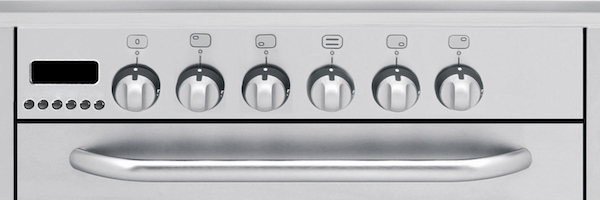Appliance manufacturers are always looking for ways to reduce costs for metal dishwasher, refrigerator and oven handles without sacrificing any fit, form, or function. Often, these cost-saving measures focus on the handle shaft. But another area that is ripe for cost-reduction and should not be neglected is the mounting methods used to attach metal handles to appliances.
Many OEMs today have moved toward favoring two handle mounting methods: refrigerator handles are typically attached using a stud mount system while oven handles generally use screw mounts. Dishwashers can use either, depending on the manufacturer and the design.
A stud mount system hangs a handle on studs that are screwed into the face of an appliance. Recessed hex screws are then used to hold the suspended handle in place.
With a screw mount system, a screw is threaded from the interior of the appliance into the back of the handle on the appliance face. These long screws do double duty, working as fastening mechanisms for the handle, as well as structural parts for the appliance.
With both mounting options, there is definitely cost-saving potential. Some techniques are universal to both; a few are specific to each and promise some unexpected benefits.
Universal Cost-Saving Techniques
There are three methods for reducing costs for refrigerator, dishwasher, and oven handles that use either stud or screw mounting systems.
Part Price Reduction
The easiest way to eliminate costs is to work with a vendor who can produce the same thing for less. While there is always a risk with this approach — the old adage “you get what you pay for” comes to mind — it’s a relatively safe, straightforward process, provided that ideal vendor exists and that you can find them.
Part Replacement
A more complicated process that involves engineering as well as sourcing is reevaluating a mounting assembly to see if there is a better way to perform the same function.
In the case of appliance handles, this is often a great approach for removing costly cast parts that can be required to realize a particular design. With the advent of hydroforming and tube stamping, attractive contours and unusual shapes can be achieved with tubular parts derived from sheet metal that have concealed weld seams or ones that have been polished to an acceptable finish.
Part Elimination
Another way to save — perhaps the best — is to simply eliminate a part through creative re-engineering.
As with part replacement, castings are a prime target in this category. Many oven handles, for instance, feature stamped brackets that have castings pressed into them. These castings provide enough thread to hold the long screws that also play a structural role. By simply using a thicker stamping, enough thread can be achieved to hold the screw, eliminating the need for any castings in the process.
Cost-Savings Measures for Refrigerator Handle Stud Mounts
Refrigerator stud mounted handles are relatively easy to assemble and replace. Some refrigerator OEMs are taking advantage of this to create handles that are meant to be installed by end users.
This consumer-installation approach provides a number of cost-saving advantages to OEMs. It:
- Cuts down on assembly labor costs
- Reduces pack-out sizes
- Reduces shipping costs
In addition, shipping refrigerators without pre-installed handles helps end users maneuver the bulky machines into place by removing components that frequently interfere with getting them through doorways and other tight spaces.
Cost-Effective Mounting Options for Screw-Mounted Dishwasher & Oven Handles
As noted above, most ranges use screw-mounting systems for their oven handles. This means they are mounted from backside using long screws that start on the inside of the oven, some of them actually holding the door together with the same screw that attaches the handle.
Giving long handle mounting screws that play a structural role enough holding power generally requires large footpads with molded brackets that have long holes featuring at least four or five threads, limiting design potential. There are, however, a couple of techniques that can be employed to open up design possibilities for these types of screw-mounted handles.
Internal Z-Bracket
If a designer wants to reduce the size of the footpad for a screw-mounted handle, it’s possible to replace a traditional molded bracket with a slide-in stamped Z-bracket with enough threads to provide structural support. The bracket clips in on one end and then is riveted to the end of the handle, holding it in place.
Flow-Drill Rivet
Working with a thin-wall tube handle, which doesn’t usually have the thickness to support any type of screw mounting, one can use a specialized Flowdrill process to extrude the tube’s surface into a cone-shaped indentation, giving the material enough depth for four to five threads. It’s a relatively slow process, but it does eliminate the need for any sort of supplementary bracket.
Conclusion
For appliance OEMs looking for ways to reduce the costs of their refrigerator, dishwasher, and oven handles without sacrificing form, fit, or function, it’s important to evaluate how the handles are mounted. Often, the methods used can be replaced with more cost-effective techniques, some of which may also offer supplemental benefits or free up design possibilities.
To discuss how inventive mounting techniques can help reduce your appliance handle costs, please contact us at Mills Products. We’ve been providing innovative manufacturing solutions for the appliance industry since our company began in 1945.


